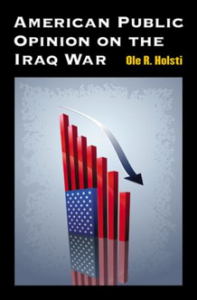 Review by Michael Schneider
Review by Michael Schneider
American Public Opinion on the Iraq War by Ole Holsti, Ann Arbor: University of Michigan Press, 2011, ISBN-13: 9780472034802, pp. 238, $40.00 (paper)
Few conflicts have so engaged, or enraged, American public opinion as the war in Iraq, especially in the first four years. Uncertainty in response to an insistent President turned to anguish and outright opposition as casualties and costs mounted between March 2003 and the growing success of General Patreaus’ troop surge and the Sunni Awakening in 2007-2008. Noted political scientist and Duke University Professor Ole Holsti analyzes the interaction of leaders and public opinion, and adroitly shows both the manipulation of public attitudes by the Bush Administration after 9-11, and the reaction as Administration claims proved false and expectations for “mission accomplished” fell flat. This is a worthwhile companion piece to the defensive memoirs by Bush Administration leaders, the insider depictions of decision-making by political analysts such as Bob Woodward, and histories of that troubled decade.
American Public Opinion on the Iraq War presents a well-structured narrative of the sequence of decisions regarding Iraq. The author breaks no new ground in use of sources or revelations of the internal decisional process in the Bush Administration. Nor does the reader come away with any special insights into personalities or rivalries – the gossip about conflict behind the scenes we all love to hate. Yet, for a short tour of the political battlefield this book recalls the milestones and major sites, and offers a useful timeline.
Holsti’s key judgment was that “…survey data apparently played little role in policy decisions [italics by the author] but they helped shape how issues were framed in what was a relentless effort to gain public support for the administration’s policies on Iraq. Although his team examined a variety of polls, President Bush “…had a very low regard for pollsters and was skeptical of evidence from their surveys, believing that his own instincts provided a better guide to the public mood.” (p. 132)
The author points out the extraordinary effort by the Bush team to sway the public, in two phases, from 2001-2003, and in 2003-2009. At the outset, this paid off, according to the author. Media and Congressional doubters lost traction and fell into line, particularly in Holsti’s view, because the Bush team framed the Iraq issue “…. as a central part of the post-9/11 ‘global war on terrorism.’”(p. 137)
[One fascinating vignette among many was especially quirky to this writer: among evidence to support its case against Saddam, the Administration cited aluminum tubes suitable for Iraq’s alleged nuclear program. Eventually, despite Administration denials, outside experts contended the tubes were re-engineered Italian surface-to-surface missiles or NATO stockpile. One think tank expert brought a mockup of the alleged rocket to my class, meeting on the Hill at the CRS. Despite prior clearance from senior security officers, the guards at three different times interrupted class to take away the (empty) rocket tube for further inspection.]Holsti’s current analysis is enriched by his long experience in the examination of public opinion and decision-making. His explanations are salted with frequent references back in time for parallels in naiveté (the British, in the face of an incipient rebellion in Mesopotamia in 1920, the U.S. in Vietnam) or comparisons of American attitudes about prior wars. He refers easily to leadership and decision-making challenges of other eras, and compares how Americans felt about other conflicts. He asks a series of questions that gauge changing American perceptions: were we right to invade … what are criteria for success … was the war in Iraq worth the loss of lives and money?
According to the author, the Bush team adopted several arguments to justify the run-up and the invasion: First and foremost was Saddam’s possession of massive stocks of WMD, especially bio- chemical weapons.
Closely related was the fact that Saddam had used such weapons against his own Kurdish population and against Iranian forces when his troops invaded Iran in early 1980. Holsti recounts how a deeply unhappy Secretary of State Powell made the case for the Administration in the UN Security Council and the public response here and abroad. The Bush Administration traded on, and ultimately spoiled, Powell’s impeccable reputation and the trust of the public.
The second argument that also had some impact on American public opinion in particular was the case against Saddam’s tyranny, his domestic brutality, ambition for regional hegemony and even global reach through support for terrorists. This all rang true to many in the public and provided supporting evidence for our invasion. But the Administration had to reach far for proof, such as the alleged meeting by a Saddam agent with al Qaeda agent in Prague, much ballyhooed by the Bush team, but later proved false.
The President and his senior leaders reinforced the “evil guy” argument in the now famous “axis of evil” comment in the 2002 State of the Union, branding Iraq, Iran and North Korea as universal threats, despite the number of real differences. Nevertheless, this case against tyranny and threats to our lives, property, and most importantly, our way of life, comported with the general panic early after 9/11 regarding Islamic Radicalism. The threats of violence and radicalism seemed so universal and pervasive.
The President and his team also played on American frustration over the grinding pace of our effort to constrain Saddam and produce change, and his clever ability to evade, distract and divide opponents.
Finally, later, came the argument for helping initiate democracy in the Arab/Islamic Middle East, which would become the one solid justification for the invasion and subsequent occupation. This rationale expanded in President Bush’s 2004 inaugural address, and must rank as one of the most sweeping analyses of history and U.S. “exceptionalist” mission.
Events on the ground did not justify any of the Bush Administration arguments, although the President was able to gain some public support initially. Historians might someday conclude that the U.S., despite our early blunders in Iraq, indeed started a process that led to stable democracy in Iraq. The link to regional change is likely to be tenuous at best. For the time being, the war counts as one of the costliest in many ways. We disposed Saddam and an odious tyranny, helped establish a new (Shi’a-dominated) government, and contributed to some stabilization. Yet important issues remain unresolved internally.
Moreover, our invasion disrupted the power balance between Iraq and Iran. It gave Iran the opportunity to capitalize on the weakness of its nemesis to help influence developments in Iraq, and to expand efforts in Syria, Lebanon, Gaza and the Gulf States. One might argue that Iran would have taken such measures regardless of who ran Iraq, but perhaps with less immediate effect. Iraq is now a transit route for Iranian influence in Syria and Lebanon.
Ironically, by lumping Iran and Iraq together, the Administration made it more difficult to differentiate among, and play off, the rivals. Instead of carefully understanding and articulating the differences, the underlying worldview of the Bush administration, post 9/11, focused on an existential threat, not only to the American people and property, but also to our way of life. This concept made it difficult for critics to argue for more nuanced understanding and approaches.
Chapter Three on partisanship debunks the myth that politics stops at the water’s edge; there have always been partisan battles before, during and after our engagement in conflicts. The author harkens back to earlier conflicts and shows a “partisan gap” in support or opposition to engagement in a war or major military intervention, centering often on perceptions of success or failure.
In Chapter four, Holsti explores the “spillover” effect of public opinion on future wars. He asks if American public regrets over the war in Iraq would inevitably lead to opposition to future conflicts and finds far greater continuity in American public opinion over the long haul in our attitudes toward engagement in conflict. In a nutshell, the public reluctantly accepts the responsibility to intervene with force, but far prefers such intervention to be internationally sanctioned and supported. A “shared leadership role” and responsibility including reliance on multi-national military forces ought to be the norm. The public abjures being the world’s policeman. These findings are confirmed by other studies, notably the writings of Steven Kull and University of Maryland Professor, I.M. (Mac) Destler in the ‘90s.
Holsti refers to one striking discontinuity: the American public increasingly believes – one might say, observes – that the rest of the world does not look favorably upon the United States. Trend-lines reported by any number of surveys after the invasion of Iraq would confirm this. We have yet to recover global approval, the advent of the Obama Administration notwithstanding.
Holsti concludes his study with a series of valuable questions for the long run, stemming from our collective, if divided, experience: Is public opinion random and volatile or sensible and stable? What is the role and influence of media over public opinion, and what should it be? Is the media as powerful as critics in a beleaguered administration assert? He faults the media for “indexing” stories in advance of the invasion, i.e. following the apparent trend of the debate for and against military action and not fulfilling its role as watchdog. The fourth estate seemed less influential in American public affairs just at a time when it should clarify choices and point out fallacies.
The author also notes the bitter partisanship that has emerged in the past decade, in some measure because of Iraq. If Iraq development is not sustained and major setbacks occur, Holsti fears the possibility of a retrospective “stab in the back” argument by the right, accusing Obama and the left of failure to capitalize on the Bush legacy of a stable, democratic Iraq. Vietnam remains fresh in his mind.
Holsti concludes this important discussion with a return to a broad question about whether public opinion is “randomly volatile or sensibly stable.” The book shows, despite his and our fears, that the American public is more sensible than volatile, although in many cases it displays “low information rationality.” That is, the public only carefully weights costs and consequences once the nation has embarked on a path that the public did not foresee. The lessons: partisanship before a major intersection with history is vital; the media watchdog must be more independent in the period of indecision. And Americans face the desperate need to learn world geography before, not after, the crisis. To expand upon Edward R. Murrow’s famous remark: the American public (not just the public diplomatists) must be in on the takeoffs, not just the crash landings.![]()
American Diplomacy is the Publication of Origin for this work. Permission to republish is freely granted with credit and a link back to American Diplomacy

